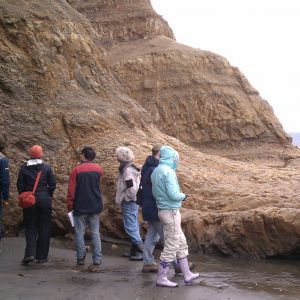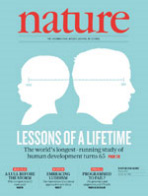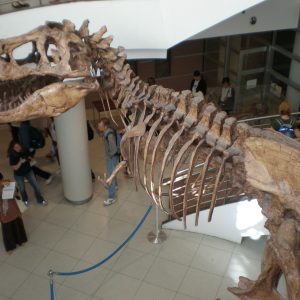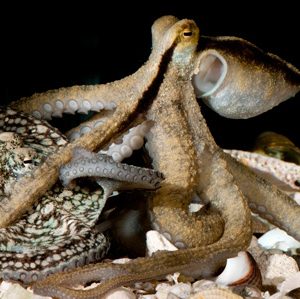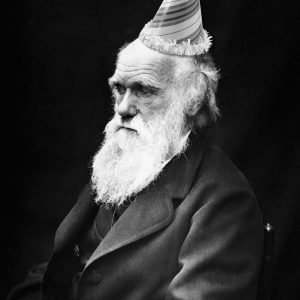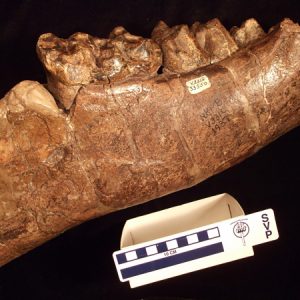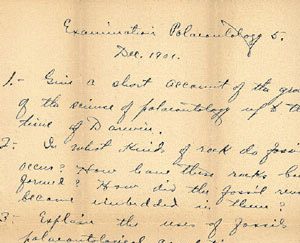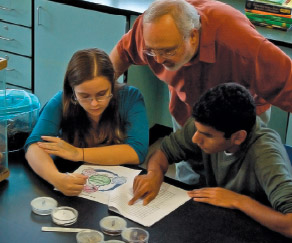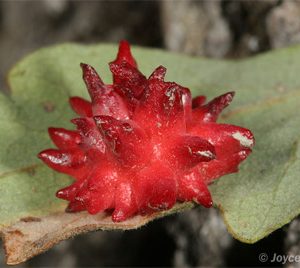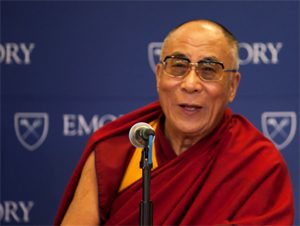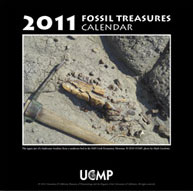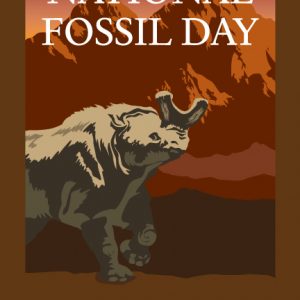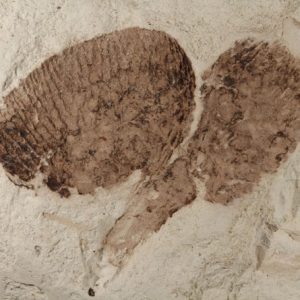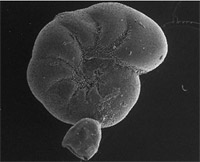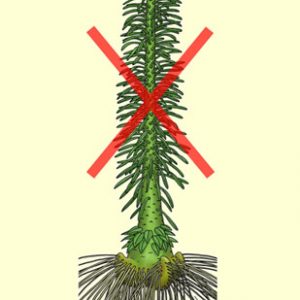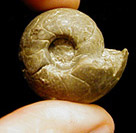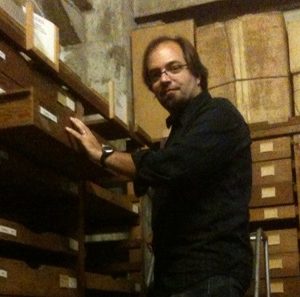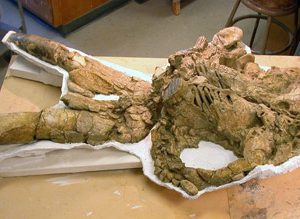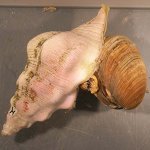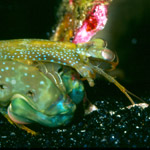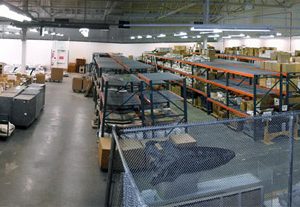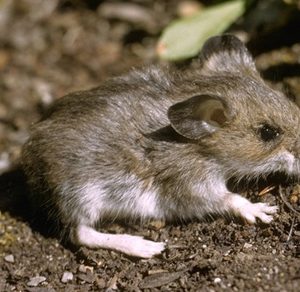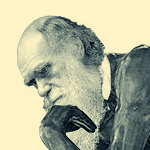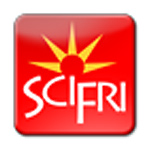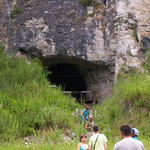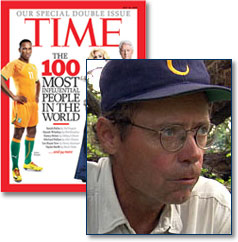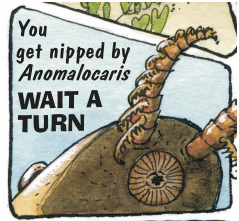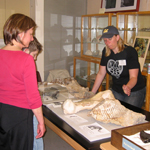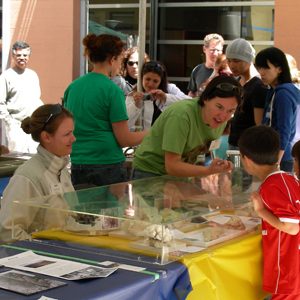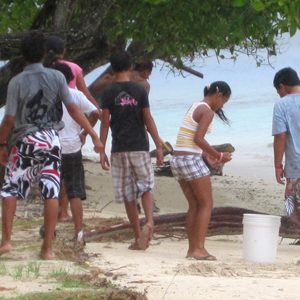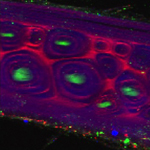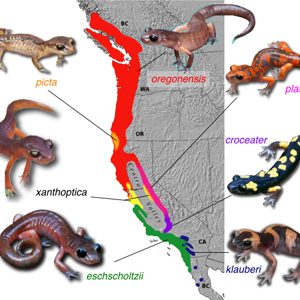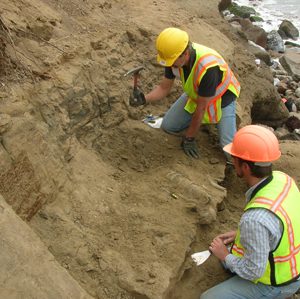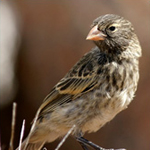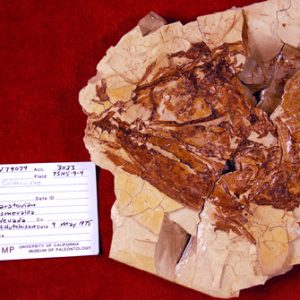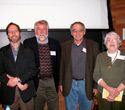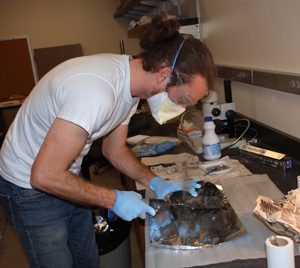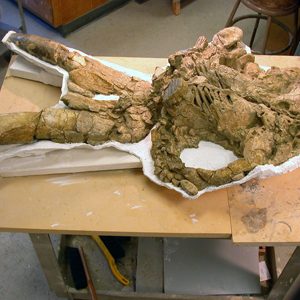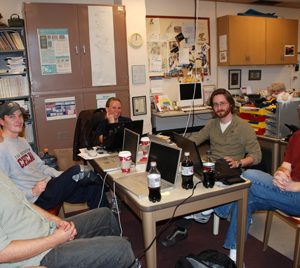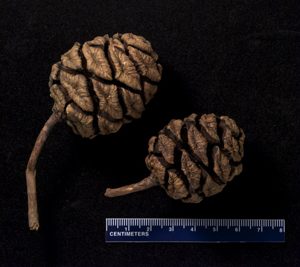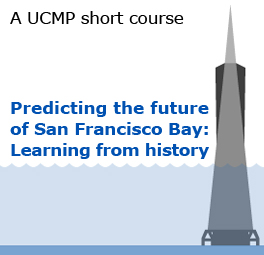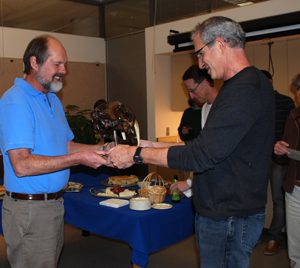David Hurt, who is co-advised by Jonathan Stillman and David R. Lindberg, has been awarded a National Science Foundation Graduate Research Fellowship. David started as a Ph.D. student Berkeley in 2010, and is examining potential effects of ocean acidification on the physiology and behavior of porcelain crabs during their development. For more about David, enjoy his audio slide show. Allison Stegner, who is advised by Tony Barnosky, has also been awarded a National Science Foundation Graduate … [Read more...] about UCMP’s award-winning students
Cal Day 2011 is here!
It's that time of year we've all been waiting for: Cal Day! This Saturday marks the one day a year UCMP opens its doors to the public and plays host to a number of events aimed to expose all those who are interested to the fascinating world of fossils. Stop by the Valley Life Sciences Building for festivities that range from digging for bones to learning about climate change. Found a fossil you need identified? Our experts have set up shop to help you out with just that. Don't forget to … [Read more...] about Cal Day 2011 is here!
UCMP’s Spring Break in the Bay Area
It's a spring break tradition here at UCMP to organize a trip exploring the geology and paleontology of a particular region. In the past, students and faculty have traveled to places like Oregon and Baja. But why run off when there's so much to see in our own backyards? In a series of trips to nearby parks, Integrative Biology graduates, undergraduates, faculty, and affiliates literally got their feet wet trekking across the product of the Bay Area's complex geologic history. From UC … [Read more...] about UCMP’s Spring Break in the Bay Area
UCMP authors write about extinction in Nature
The latest edition of the journal Nature includes a paper authored by Tony Barnosky entitled "Has the Earth's sixth mass extinction already arrived?" Co-authors include UCMP's Susumu Tomiya, Brian Swartz, Tiago Quental, Charles Marshall, Jenny McGuire, Emily Lindsey, Kaitlin Maguire, Elizabeth Ferrer and the Integrative Biology department's Nicholas Matzke, Guinevere Wogan and Ben Mersey. They used new paleontological information to make an apples-to-apples comparison between current … [Read more...] about UCMP authors write about extinction in Nature
The Opportunistic T. rex
Looks like the tyrant lizard wasn't so scary after all. UCMP's Mark Goodwin and Jack Horner, curator of paleontology at the Museum of the Rockies, have been working in the late Cretaceous Hell Creek Formation of Eastern Montana for decades, an area famous for its impressive fossil assemblages including fish, mammals, and dinosaurs like Tyrannosaurus rex. Based on a census of predator and prey found at several of the time intervals represented in the Hell Creek Formation, Goodwin and Horner … [Read more...] about The Opportunistic T. rex
Happy Valentine’s Day from the Caldwell Lab
Love is in the water, and UCMP's Roy Caldwell has the photos to prove it! The cephalopod resource website TONMO has posted a sequence of Roy's crystal-clear photos depicting a pair of mating Abdopus aculeatus octopuses. Readers can follow this relationship from the first, tentative moments of courtship through to a brood of adorable octopus eggs. Click through to TONMO for the photo essay and accompanying commentary. … [Read more...] about Happy Valentine’s Day from the Caldwell Lab
Happy Birthday, Darwin!
Our old buddy Charles Darwin turns 202 this Saturday and the Berkeley Natural History Museums aren't letting him forget it. In addition to a Darwin-inspired photo contest, the Essig Museum of Entomology, on behalf of the Entomology Student Organization, will be giving several tours of their new museum space on Friday before a birthday party complete with photo judging and, you guessed it, cake! To find out more about how people across the world are celebrating Darwin Day, check out the … [Read more...] about Happy Birthday, Darwin!
Mastodons in the Caldecott?
Yes! And that's not all! Construction of the new fourth bore of the Caldecott Tunnel on Highway 24 is cutting through fossiliferous rocks in the East Bay Hills deposited some nine to ten million years ago. Rocks of this age have produced fossils of mastodons, several kinds of horses and camels, and carnivores including a hyena-like dog and a saber-tooth cat – so those involved in the drilling process are keeping an eye out for any such finds. To illustrate what has been found in earlier … [Read more...] about Mastodons in the Caldecott?
UCMP awarded three-year grant to catalog our archives
We are pleased to announce the receipt of a grant of $236,200 from the Mellon Foundation to catalog our archives The funds are administered by the Council on Library and Information Resources (CLIR) through their "Cataloging Hidden Special Collections and Archives: Building a New Research Environment" program. In recognition that "libraries, archives, and cultural institutions hold millions of items that have never been adequately described," the CLIR awards grants in order to support … [Read more...] about UCMP awarded three-year grant to catalog our archives
UCMP websites win a Science Magazine education award
The news is finally out! Understanding Evolution and Understanding Science have won the Science Prize for Online Resources in Education (SPORE) award. The prize honors websites that encourage innovation and excellence in science education. We are proud to have been selected from among hundreds of sites to receive this prestigious award — and we are glad to be able to finally let everyone know about it! We’ve been trying to keep it a secret for almost a year now ... Check out our essay … [Read more...] about UCMP websites win a Science Magazine education award
Upcoming workshop: Insect-induced Plant Galls of California
Insect-induced Plant Galls of California September 18, 2011 Kathy Schick, Joyce Gross, and Diane M. Erwin UC Berkeley Co-sponsored by the Essig Museum of Entomology and the University of California Museum of Paleontology Plant galls provide a fascinating array of color and texture on most of the plants in our California landscape. Galls, growths of plant cells that are not normal plant organs, can be induced by a number of organisms. The most numerous as well as most beautiful and intriguing … [Read more...] about Upcoming workshop: Insect-induced Plant Galls of California
UCMP’s Evo 101 in Tibetan!
Since its launch in 2004, the audience of the Understanding Evolution website has continued to grow, and the site is evolving in response to the needs of that audience. The site now averages more than a million page accesses per month during the academic year, but additionally there is a large international audience that is visiting UE "sister sites." Through partnerships with educational organizations abroad, the UE site is now available in Spanish and Turkish and most recently has been … [Read more...] about UCMP’s Evo 101 in Tibetan!
National Fossil Day at UCMP
Yesterday was the first ever National Fossil Day and UCMP pulled out all the stops! Come check out the new online exhibit, Fossils in our parklands: Examples of UCMP service and stewardship, featuring fossils in UCMP's collection from national and state parks in California, Nevada, Oregon, and Montana. The museum played a pivotal role in the creation of some of the featured parks and we're happy to highlight our shared histories. Additionally, the 2011 UCMP Fossil Treasures Calendar is now … [Read more...] about National Fossil Day at UCMP
UCMP celebrates National Fossil Day!
On October 13, come celebrate the first ever National Fossil Day with UCMP! National Fossil Day is a nation-wide event organized by the National Park Service in partnership with American Geological Institute to promote public awareness and stewardship of fossils, as well as to foster a greater appreciation of their scientific and educational values. It falls during Earth Science Week and we here at Cal have been busily preparing for the festivities! To highlight the museum’s history of … [Read more...] about UCMP celebrates National Fossil Day!
In “Dr. K’s” footsteps: A glimpse of Turkey in the UCMP paleobotany collections
Why would a Swedish paleobotanist go to the UCMP during a cold summer to study a collection of early Miocene plant fossils from Turkey instead of going to Turkey to enjoy a warm summer and great fieldwork? The reason - UCMP is home to a collection of fossil plants made over 40 years ago by Turkey native Dr. Baki Kasapligil (1918-1992). Born in Çankaca, Turkey, Baki was raised in Istanbul – his father was Turkish and his mother from the country of Georgia. As a young man he attended UC Berkeley … [Read more...] about In “Dr. K’s” footsteps: A glimpse of Turkey in the UCMP paleobotany collections
Using foraminifera as environmental indicators after an oil spill
The shells of abundant, tiny, marine organisms known as foraminifera deform when exposed to environmental pollutants. When foraminifera die they leave behind these shells as a record of the conditions through which they lived. A team of researchers, including professor emeritus/UCMP curator Jere Lipps, reported on the usefulness of forams as environmental indicators after studying the impact of the 1978 Amoco Cadiz oil spill on the Brittany Coast. This work was presented on September 7 by … [Read more...] about Using foraminifera as environmental indicators after an oil spill
Museum nomads
For many paleobiologists summer is that part of the year during which data is gathered in its purest form: fossils. Such summers may take you in diametrically opposite directions, though. Some bring broadly boasted outdoor adventures of fieldwork. Others, however, take you deeper and deeper into the collection labyrinths in the dark bowls of natural history museums around the globe. Despite what others may let you believe - and don’t tell anyone we told you - fieldwork is often boring, tedious … [Read more...] about Museum nomads
Hiring for a faculty position in invertebrate paleobiology
The Department of Integrative Biology at the University of California, Berkeley, is soliciting applications for a tenure track position (Assistant Professor) in Paleobiology. The successful candidate will also serve as a curator in the University of California Museum of Paleontology. If you're interested, please read the complete job listing. … [Read more...] about Hiring for a faculty position in invertebrate paleobiology
$25,000 gift to support COPUS
We are pleased to announce the receipt of an unrestricted gift in the amount of $25,000 from The Whitman Institute to support the Coalition on the Public Understanding of Science (COPUS) project. Being involved in COPUS has been an extraordinary experience, but it is not all that easy to explain – probably because it is so simple. It is all about connecting people and ideas and the common thread is sharing science. The idea for COPUS began in 2006 at UCMP with an NSF-funded meeting of a small … [Read more...] about $25,000 gift to support COPUS
Quental and Marshall Feature Article
Congratulations to Tiago Quental and Charles Marshall whose paper, Diversity dynamics: molecular phylogenies need the fossil record, was designated as the featured article in the June 21, 2010 issue of Trends in Ecology and Evolution. When asked to reflect on the importance of the fossil record in our understanding of today’s biodiversity, Tiago responded: Biologists, typically overlook the fossil record when trying to explain how we got to our current biodiversity, in part because for many … [Read more...] about Quental and Marshall Feature Article
Fossils in our own backyard
Museum visitors often ask if our fossils come in from expeditions to remote places. I tell them that some do, but many are found right here in California by local people or via construction projects. For example, our most recent addition to the collections is part of a mammoth along with some other Pleistocene-aged mammals. They were uncovered during the excavation of a storm water retention basin on the campus of Los Positas College in Livermore. Our collection’s next addition of Bay Area … [Read more...] about Fossils in our own backyard
Paleo Video: Snail shell mystery
If you study snails, you’ve got to be patient. But two UCMP graduate students, Jann Vendetti and Scott Fay, used time-lapse photography to kick slow snails into high gear. They discovered some surprising behavior in snails living today—and in snails that lived millions of years in the past. The video features snails of two species: Kelletia kelletii, and Busycotypus canaliculatus (also known as Busycon canaliculatum). This group of animals is so numerous and diverse—in lifestyle, natural … [Read more...] about Paleo Video: Snail shell mystery
A tribute to Dawn E. Peterson
It is with great sadness that I report the passing of Dawn E. Peterson, who succumbed to brain cancer on June 29 at the age of 61. They were truly an extraordinary one-of-a-kind character - a bipolar, transgender, self-taught ostracodologist! As a young person at the University of Minnesota, Don's mental disability surfaced and abruptly ended their first semester. The disorder led them to spiral downward into the darkest realms of life before settling down as a sculptor and marrying. Their … [Read more...] about A tribute to Dawn E. Peterson
Even a mantis shrimp is what it eats
Ask most anyone what butterflies use their wings for or what fish do with their fins and you will undoubtedly hear an answer like, "Wings are used for flying and fins are used for swimming!" Some body parts just seem so well-adapted to perform certain functions; this is why there is a paradigm in biology that "specialized" body parts correspond to specific ways in which animals go about their daily business. In other words, specialization in morphology corresponds to specialization in ecology. … [Read more...] about Even a mantis shrimp is what it eats
The latest UCMP newsletter is now online
Find out even more about what's happening at UCMP by reading the latest online edition of our newsletter. Read about how we've secured important fossil collections by moving them from run-down off-site storage to an immaculate new facility. Find out how UCMP fared at the latest Cal Day. Get an update on the field work of paleobotanist Cindy Looy in Caprock Canyon State Park. Plus a letter from the director, awards, accolades, and more! And if you'd like to receive the UCMP newsletter by … [Read more...] about The latest UCMP newsletter is now online
Global warming and declining mammal diversity: new research in Nature
Popular images of Ice Age California tend to feature enormous, extinct mammals like mammoths and saber-toothed cats. By contrast, new research published in Nature examines populations of small mammals that survived through the end of the Ice Age and how they were affected by the climate change. The research team of Jessica Blois (formerly at Stanford, now at University of Wisconsin, Madison), Elizabeth Hadly (formerly of UCMP, now at Stanford) and Jenny McGuire (UCMP) studied fossilized … [Read more...] about Global warming and declining mammal diversity: new research in Nature
Marine vertebrate paleontology in Half Moon Bay
This week, we welcome guest blogger Robert Boessenecker. Bobby has been interested in paleontology since he was a kid. He grew up in the Bay Area; when he found Miocene shark teeth in the Santa Cruz Mountains, he was hooked. He first got involved with the UCMP when he was a high school freshman — he visited the museum with his dad, to interview UCMP Assistant Director Mark Goodwin for a school project. Bobby is now getting a Masters' degree at Montana State University. He studies the taphonomy … [Read more...] about Marine vertebrate paleontology in Half Moon Bay
Think Evolution II: a summer institute for science educators
Join us at the UCMP for a fun-filled five days of evolutionary explorations with biologists and educators from the University of California. On August 2-6, UCMP and the National Center for Science Education will host a workshop for middle school, high school, and community college biology teachers and science educators. Scientists will discuss their research, covering topics like molecular evolution, developmental biology, and human evolution. Learn how you can integrate cutting-edge … [Read more...] about Think Evolution II: a summer institute for science educators
Special exhibit: Fossil eggshell
This week, we've launched a new online special exhibit — Fossil eggshell: Fragments from the past. This is the best online source of information about fossil eggshell — you can't find this info anywhere else! This special exhibit was created in collaboration with Laura E. Wilson, Karen Chin and Emily S. Bray, from the University of Colorado, Boulder, and Frankie D. Jackson from Montana State University. We can learn a lot from fossil eggshell. Using scanning electron microscopy, we can examine … [Read more...] about Special exhibit: Fossil eggshell
UCMP’s Tony Barnosky on Science Friday
Mounting evidence suggests we may be on the cusp of a major extinction event. Last week, UCMP Faculty Curator Tony Barnosky talked about modern extinctions on Science Friday, a weekly science talk show on NPR. Tony was joined by Barry Sinervo, Professor at UC Santa Cruz, George Amato, of the Sackler Institute and the American Museum of Natural History, and Vance Vredenburg, Assistant Professor at San Francisco State University. In a lively conversation, Tony and the guests discussed many … [Read more...] about UCMP’s Tony Barnosky on Science Friday
Evo in the news: Making sense of ancient homonin DNA
When archaeologists discovered a 40,000 year old pinky bone in a Siberian cave, everyone wondered who the bone belonged to. Researchers extracted DNA from the fossil and used it to construct an evolutionary tree to see how the pinky bone's owner was related to modern day humans and Neanderthals. Scientists were surprised by what they found — read more about it in this month's Evo in the news: Making sense of ancient homonin DNA. Each month, the UCMP's Understanding Evolution website features an … [Read more...] about Evo in the news: Making sense of ancient homonin DNA
Congratulations Tim White!
Congratulations are due to Tim White, Director of the Human Evolution Research Center and Faculty Curator at the UCMP! Tim was selected by Time Magazine as one of The 100 Most Influential People in the World. Tim receives this recognition for his work on human evolution. This past fall, Tim and his colleagues published numerous papers on Ardipithecus ramidus, the oldest and most complete skeleton of a human ancestor. Congratulations, Tim! … [Read more...] about Congratulations Tim White!
The game of prehistoric life
Evolve or Perish is a new board game – not from the makers of Monopoly, but from ETE, the Evolution of the Terrestrial Ecosystems Program, at the Smithsonian National Museum of Natural History. UCMP Faculty Curators Cindy Looy and Ivo Duijnstee designed the game in collaboration with illustrator Hannah Bonner. Hannah is well-known for her cartoon paleobooks When Bugs Were Big and When Fish Got Feet. The three enjoy collaborating -- Hannah created the logo for Cindy's lab's web site, and she is … [Read more...] about The game of prehistoric life
Cal Day at the UCMP
Thanks for joining us on Cal Day! Here are some photos from a few of the UCMP's Cal Day events. At Fun with Fossils, visitors used microscopes to look for fossils. They picked through matrix collected at the Bug Creek Anthills in Montana. People found reptile vertebrae, fish scales… and one little girl found a dinosaur tooth! The courtyard of VLSB was buzzing as hundreds of visitors perused the Biodiversity Roadshow. This exhibit included specimens from many of the Berkeley Natural History … [Read more...] about Cal Day at the UCMP
Visit the UCMP on Cal Day!
Join us at the UCMP on Cal Day, Saturday April 17! Events run from 9am to 4pm; check the schedule for a full listing of activities. Here are just a few of the Cal Day events at the UCMP: ~ Take a tour of the collections with a museum scientist. The collections are open to the public just one day a year, so this is your chance! Tours are held throughout the day, but tickets are first-come, first- served, and they go fast — come early to pick up your free tickets in advance. ~ Visit the special … [Read more...] about Visit the UCMP on Cal Day!
Middle schoolers and marine biodiversity in Moorea
Scientists from institutions like the UCMP travel all around the world and interact with many local communities. Last year the Berkeley Natural History Museums launched a project called the GK-12 Moorea fellowship to foster collaboration between graduate students and local communities in Moorea, French Polynesia. The program sends one graduate student to Moorea, a small island about 10km from Tahiti, to teach interactive science lessons in public schools and do ecological research. As the … [Read more...] about Middle schoolers and marine biodiversity in Moorea
X-ray analysis of fossil whale baleen
Two years ago I approached UCMP Assistant Director Mark Goodwin and asked if he had any room for some student help in his research. I had no previous experience in paleontology, just a passion for learning about dinosaurs and biology. Now, as a third-year graduate student in the Department of Materials Science and Engineering, I work on a variety of projects with Mark and the UCMP. For my own research, I study the micro- and nano-scale features in fossil bone with electron microscopy. I have … [Read more...] about X-ray analysis of fossil whale baleen
Highlights from Understanding Evolution
Ring species are often touted as examples of speciation in action — and the Ensatina salamander, which forms a ring around California's Central Valley, is a classic example. Biologists discovered this ring species back in the 1950s, and investigations of Ensatina continue today. Learn more about Ensatina in this research profile of biologist Tom Devitt, on the UCMP's Understanding Evolution website. Tom is a graduate student in Integrative Biology here at UC Berkeley. The profile follows him … [Read more...] about Highlights from Understanding Evolution
Creatures from the black lagoon
Very little was known about wetland ecology back in 1869, when Samuel Merritt dammed a former tidal slough and began developing its surrounding wetland as his "Jewel of Oakland." By restricting the flow of waters in and out of the newly created tidal lagoon, a.k.a. Lake Merritt, silt and algae were allowed to accumulate and within a few years the lake had become a bit of an environmental disaster. Nevertheless, part of it was designated by Teddy Roosevelt as our nation's first wildlife refuge, … [Read more...] about Creatures from the black lagoon
Fossils found fortuitously
Not all fossils are discovered by paleontologists combing the earth on special expeditions. Many fossils are found by accident — particularly during construction projects. Impressive fossils, like whales, mammoths, and sloths, have been found while digging foundations for buildings, leveling land for highways, and excavating subway tunnels. This spring, the UCMP blog will take you on a tour of Bay Area construction sites, past and present, to show you some of the fossils underfoot in the … [Read more...] about Fossils found fortuitously
Evo in the news: Speciation in real time
Speciation isn't always slow — sometimes, we can see evidence of evolution over a very short period of time. This month's Evo in the news: Speciation in real time looks at two examples of speedy speciation. The Central European blackcap, a bird, could be on the verge of a speciation event — over the past 30 years, researchers have seen a split in the behavior and morphology of two groups of blackcaps. Speciation has occurred in another bird species over a similar time period: the Galapagos … [Read more...] about Evo in the news: Speciation in real time
Fish in the UCMP
It is pretty unusual to see fish in the UCMP. It’s not that we don’t have any fish specimens — we have over a million fossilized fish fragments. It’s just that none of our museum scientists focus on fish, and so the museum’s fish parts tend to stay in the cabinets. But this past summer, Ralph Stearley of Calvin College visited the UCMP, and he did a little fishing. Ralph pulled some spectacular specimens from the murky depths of the cabinets. The two specimens shown here are exceptional — … [Read more...] about Fish in the UCMP
Predicting the future of San Francisco Bay: Learning from history
Hundreds of thousands of people cross San Francisco Bay each day. But as commuters zip through the BART tunnel or drive over the bridges, they probably don't think about what the Bay looked like in the past — or what it will look like in the future. On Saturday, February 6, over 150 people attended the UCMP's annual Short Course, Predicting the future of San Francisco Bay: Learning from history. Throughout the course's five talks, they saw a very different view of San Francisco Bay. A theme … [Read more...] about Predicting the future of San Francisco Bay: Learning from history
How many mammoths?
A few weeks ago, the UCMP welcomed visitor Jake Enk, a graduate student from McMaster University in Hamilton, Ontario. Jake visited the UCMP to saw off chunks of fossil mammoth teeth. Yes, you read that right. He took a small saw, sterilized the blade with bleach, and sliced off a small piece of tooth. Even after tens of thousands of years, mammoth teeth still contain DNA. Jake will put a little piece of the tooth in a test tube, and use a series of chemicals to purify the mammoth DNA. He does … [Read more...] about How many mammoths?
Lupé’s story, part 2: Prototyping the mammoth exhibit
UCMP graduate student Kaitlin Maguire is working with the Children’s Discovery Museum in San Jose to develop a new exhibit about the life of Lupé, a mammoth fossil that was found in the nearby Guadalupe River. This is the second in a series of blogs about Lupé and the new exhibit. Read Kaitlin’s first Lupé blog here. Development of the Lupé Story Exhibition is moving along quickly as exhibit ideas come to life in prototyping labs, in which the development team at the Children’s Discovery … [Read more...] about Lupé’s story, part 2: Prototyping the mammoth exhibit
Collaborating, with the help of the collections
A few weeks ago, we blogged about the discovery of a new species of dinosaur, Tawa hallae. Two UCMP alums, Sterling Nesbitt and Randy Irmis, described this new dino in the journal Science. A few weeks ago, Sterling, Randy, and two of their Tawa co-authors, Nate Smith and Alan Turner, visited the UCMP. They've come from Texas, Utah, Illinois, and New York, to work together and delve into the UCMP's collections. Along with UCMP Faculty Curator Kevin Padian and graduate student Sarah Werning, they … [Read more...] about Collaborating, with the help of the collections
Conifer evolution workshop
If there were a Guinness Book of World Records for conifers, California would be one of the top record holders: the Golden State has the tallest conifer, the most massive conifer, and the oldest conifer. Learn much more than just conifer trivia at an upcoming workshop, The Origin and Evolution of Conifers, co-hosted by the UCMP and The Jepson Herbarium. Through talks, discussions, and a hands-on lab, you'll learn all about the origin, evolution, and diversification of this unique plant group. … [Read more...] about Conifer evolution workshop
UCMP short course: Predicting the future of San Francisco Bay
How will sea level rise and climate change affect San Francisco Bay in the coming years? To predict the future, we need to look at the past — history shows us that San Francisco Bay has undergone some major changes throughout its history. Learn more about the Bay at this year's UCMP Short Course, Predicting the future of San Francisco Bay: Learning from history. This all-day course will be on Saturday, February 6, at UC Berkeley. It features talks by five renowned Bay Area scientists, as well as … [Read more...] about UCMP short course: Predicting the future of San Francisco Bay
Thank you, Roy Caldwell!
At the close of 2009, Roy Caldwell stepped down from his position as UCMP Director. Thankfully, Roy isn't going anywhere — he will continue to be a Faculty Curator at the museum and a professor in the Department of Integrative Biology. Roy became the interim director in 2005 and director in 2006. Says Roy, "Acutely aware of my lack of training and experience as a paleontologist, the most I could hope for was to be a facilitator — and hope that I didn't muck things up. Judging by the high quality … [Read more...] about Thank you, Roy Caldwell!
Welcome Charles Marshall, new UCMP Director!
Let’s give a great, big UCMP welcome to Charles Marshall — the new Director of the UCMP! Charles recently joined the faculty of the Integrative Biology department after being on the faculty at Harvard as well as being the curator of invertebrate paleontology at Harvard’s Museum of Comparative Zoology. "Greetings to all members and friends of UCMP," says Charles. "I am very excited to be part of UCMP and look forward to meeting you all, and in joining you as we work to make UCMP an even … [Read more...] about Welcome Charles Marshall, new UCMP Director!


